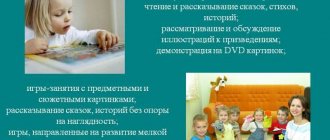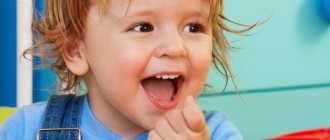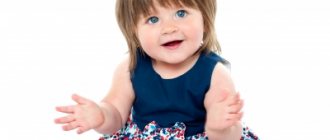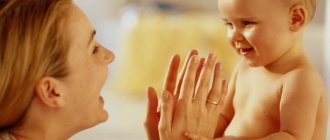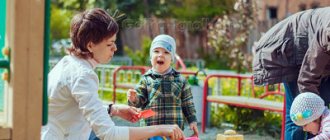What mistakes can parents make when developing their child’s speech?
Often the child is overly patronized and protected, they try to predict his desires - of course, out of love for him.
But then the baby does not develop the desire to work independently, he does not learn to express his thoughts through speech, and many processes in his development may be inhibited. • Intuition and love help loved ones understand a child literally at a glance. But communicating with unfamiliar people in unusual conditions will be difficult for him, and in the worst case, acutely uncomfortable. To prevent this from happening, as you grow older, you need to enter into conversations more often with new and new interlocutors, and then the child will simply be forced to improve his speech understanding skills.
• Some parents underestimate, while others overestimate, the requirements for the baby’s speech. In the first case, they do not demand anything from the child, all his wishes are guessed and immediately fulfilled, in the second, they constantly pester him: “Tell me!”, “Repeat!”. Sometimes in one family two extreme approaches are used at once: for example, dad demands, and grandmother takes care. This has a very adverse effect on the child’s speech development.
• Try to eliminate lisping, “baby talk,” and constant onomatopoeia when communicating with your baby. The parent's speech is a model for the child.
• Parents can speak very quickly or, conversely, too slowly, without pauses and different intonations, monotonously. It is important to use all the richness and diversity of language when developing a child’s speech.
• Do not try to speed up the baby's natural speech development. Avoid overwork from speech classes and memorization of poetry.
What is child speech?
Surely you have no doubt when you are asked what the word “speech” or “language” means. However, most people struggle to find a clear and understandable definition. This is because “speech” is a really broad concept! Let's figure out what speech is. Let's start with the obvious.
- Speech consists of words combined into sentences.
- Speech (language) is used for speaking, reading and writing.
- There are many different languages, usually associated with different countries.
However, this is not quite the entire concept of speech. For example, the same word can be used for very different effects. It all depends on the tone of voice and even facial expression during a conversation. Not all languages can be spoken or written. For example, take sign language. Languages may differ in nature. There are, for example, languages such as Braille, programming languages or Chinese.
Our goal now is to stick to the simple idea that language is the ability to communicate effectively .
Basically, when we talk about the definition of speech, in a child context, communication covers everything. From crying to understanding yes and no (receptive language) to hooting and speaking (expressive language).
Read more about SPEECH DEVELOPMENT OF CHILDREN AT AN EARLY AGE.
When to see a speech therapist
You should contact a speech therapist if:
• up to 2.5 years the child has not developed speech or the child’s vocabulary is no more than 10 words. A qualified speech therapist can not only correct sound pronunciation, but also stimulate the appearance of speech in non-speaking children;
• a child of 1.5 - 2.5 years old does not utter normal, understandable words like “mother”, “woman”, “bi-bi”, “cat”, “drink”, “go”, but speaks in his own language language, and a lot and actively (no need to wait 3 years - go to a speech therapist right now);
• a child of 4 – 5 years old softens all sounds: “kisya”, “shchapka”, “taynik”, “lampotka”;
• a child 3 years of age and older distorts the syllabic structure of a word, skips, rearranges syllables, adds new ones: “puvitsa” - “button”, “gebimot” - “hippopotamus”, “pepitan” - “captain”;
• the child is over 6 years old and does not pronounce any sounds of his native language. At this time, the phonetic system is fully formed, and the baby should speak correctly;
• the child began to repeat the first sounds, syllables, words (speech hesitations appeared).
You should also be more careful if your child is learning several foreign languages at once: sometimes in such cases he may develop dysgraphia, a disorder in mastering written language. To avoid deviations, you need to work with your child as soon as he becomes familiar with letters - usually this skill comes at 4 - 6 years old.
Early childhood is a sensitive period for language acquisition. The child’s autonomous speech transforms and disappears quite quickly (usually within six months). Words that are unusual both in sound and meaning are replaced with words of “adult” speech. Conditions of speech development. The transition to a new level of speech development is possible only in favorable conditions - with full communication between the child and adults.
Stages of speech development. At the age of 1 to 3 years, there are 3 stages of speech development in children. The first stage of speech development occurs between the ages of one and 1.5 years and is associated with the formation of passive and active speech. Passive speech. At an early age, the passive vocabulary—the number of words understood—grows rapidly. The adult’s speech, which organizes the child’s actions, is understood by him quite early. By this time, the child begins to understand the adult’s instructions regarding joint actions. However, until about 1.5 years of age, the child only develops understanding of speech, with a very slight increase in the active vocabulary. First of all, the child learns the verbal designations of the things around him, then the names of adults, the names of toys and, finally, parts of the body and face. These are all nouns and are usually acquired during the second year of life. By the age of two, a normally developing child understands the meaning of almost all words related to the objects around him. Active speech. Active speech is also developing intensively: the active vocabulary is growing, while the number of words spoken is much smaller than those understood. A child begins to name things in his own words at the age of about one year. By this time, children usually already have ideas about the world around them in the form of images. Under these conditions, to begin mastering speech, the child only has to associate the images he has with combinations of sounds pronounced by adults in his presence when there are corresponding objects or phenomena in his field of vision. Speech grammar. The first period of speech development, covering the age of 1 to 1.5 years, is characterized by weak development of grammatical structures and the child’s use of words mostly unchanged. The second stage of speech development occurs at approximately 1.5 to 2.5 years of age. In the second year of life, the child’s active vocabulary increases sharply. By the age of one and a half years, a child on average learns from 30-40 to 100 words and uses them extremely rarely. After one and a half years, a sharp leap in speech development occurs. By the end of the second year of life, children already know approximately 300 words, and by the age of three, 1200-1500 words. At this same stage of speech development, children begin to use sentences in their speech. The child's interest in the world around him grows. The child wants to know, touch, see, hear everything. He is especially interested in the names of objects and phenomena, and every now and then he asks adults the question: “What is this?” Having received the answer, the child independently repeats it, and, as a rule, learns the name immediately, without much difficulty remembering and reproducing it. A child’s passive vocabulary at this age is not much different from the active one, and their ratio at the age of three is approximately 1:1.3.
Offers. At first, the child uses one-word sentences that express a complete thought. Such words-sentences arise in connection with some specific, visually perceived situation. Then two-word sentences appear, including both a subject and a predicate. The meaning of such two-word sentences is the same: a certain thought or a complete statement. This is most often the subject and his action (“Mom is coming”), the action and the object of the action (“give me a roll”, “I want candy”), or the action and the place of action (“the book is there”). At this age, children learn to combine words, combining them into small two- or three-word phrases, and they progress from such phrases to complete sentences quite quickly. The second half of the child’s second year of life is characterized by the transition to active independent speech, aimed at controlling the behavior of people around him and mastering his own behavior. Speech grammar. The second period of speech development represents the beginning of the intensive formation of the grammatical structure of a sentence. At this time, individual words become parts of a sentence, and their endings are agreed upon. By the age of three, the child generally correctly uses cases, constructs multi-word sentences, within which the grammatical coordination of all words is ensured. Around this time, conscious control over the correctness of one’s own speech utterance arises. The third stage of speech development corresponds to the age of 3 years. By the age of three, the basic grammatical forms and basic syntactic structures of the native language are mastered. In a child’s speech there are almost all parts of speech, different types of sentences, for example: “Do you remember how we went to the river, dad and Nyura swam, and where was mom?” “I am my father’s and mother’s son, the nephew of all my uncles, my grandmother’s and grandfather’s grandson.” “You are big, and I am small. When I’m long - up to the carpet... up to the lamp... then I’ll be big.” The most important acquisition of a child’s speech at the third stage of speech development is that the word acquires an objective meaning for him. The child uses one word to denote objects that are different in their external properties, but similar in some essential feature or way of acting with them. The first generalizations are associated with the emergence of objective meanings of words. Functions of children's speech . The communicative function of children's speech is associated with the use of speech as a means of communication, controlling the behavior of other people and self-regulation. At the age of one to three years, the child’s social circle expands - he can already communicate through speech not only with close people, but also with other adults and children. What does a child say when communicating with adults? Basically, the child’s practical actions or the visual situation in which communication takes place. The child answers the adult’s questions and asks questions about what they are doing together. When a child enters into a conversation with a peer, he delves little into the content of the other child’s remarks, therefore such dialogues are poor, and children do not always answer each other. The semantic function of children's speech is associated with determining the meaning of words and the acquisition of generalized meanings by words.
Between one and three years of a child’s life, there is a stage of speech development when polysemantic words appear in the child’s speech. Their number is relatively small, from 3 to 7% of a child’s vocabulary. Next, polysemantic words disintegrate, and words in the child’s speech acquire stable meanings. At the age of one to 1.5 years, stages of development of verbal generalizations can be distinguished in a child’s speech. At the first stage, the child groups objects according to their external, most striking and conspicuous features. At the second stage, generalization occurs according to functional characteristics, that is, according to the role in which objects are used in children's play. The third stage is characterized by the ability to identify general and stable characteristics of objects, reflecting their nature and independent of the situational, functional use of these objects. Cognitive function of speech. Around three years of age, the child begins to listen carefully to what adults say to each other. He especially likes listening to stories, fairy tales, and poems. At 2-3 years old, understanding of speech-story appears. Stories relating to things and phenomena surrounding the child are easier to understand. In order for him to understand a story or fairy tale, the content of which goes beyond the limits of the situation directly perceived by him, additional work is needed - adults must specially teach this. The emergence of the cognitive function of speech determines an important moment in the child’s speech development. It indicates that the child is already able to perceive reality not only directly through the senses, but also in its ideal, conceptual reflection in language. Psychological mechanisms of speech development. How is a child’s speech formed from the point of view of the psychological mechanisms of this process? There are three main mechanisms of language acquisition: - imitation, - formation of conditioned reflex associations, - formulation and experimental testing of empirical hypotheses. Imitation influences the formation of all aspects of speech, but especially phonetics and grammar. This mechanism is realized when the child shows the first signs of the corresponding ability. But imitation is only the initial stage of speech development. Without the next two stages, it is not able to lead to great success in language acquisition. The function of conditioned reflex conditioning in the production of speech is that the use of various rewards by adults accelerates the development of children's speech. It cannot be said, however, that without this the child will not develop speech at all. It is known that in orphanages children are deprived of individual attention. And yet, under these conditions, the child’s speech is still formed by the required time. The formulation and testing of hypotheses as a mechanism of speech acquisition is confirmed by the facts of active children's word creation. However, isolated on its own, this mechanism overly intellectualizes the process of speech development in young children. Apparently, speech development at an early age is explained by a combination of all three learning mechanisms considered.
Today, the issue of speech development in preschoolers is especially acute. This is probably due to the fact that children, and adults too, began to communicate more with computers and other means of technological progress than with each other.
Preschool age is the most favorable for the development of speech and the formation of a culture of verbal communication. Practice shows: this is a very labor-intensive and responsible work that requires a certain system and patience on the part of the teacher in selecting the most effective means and methods of teaching.
But in order to teach children something, the teacher needs to work on himself. A preschooler spends most of his time in kindergarten: he communicates with the teacher, learns a lot from him, including speech culture. Therefore, I pay special attention to my speech. The child perceives the adult’s speech as a model; the teacher must speak correctly, without distorting sounds, clearly articulating each word, without rushing, without “eating” endings. You need to pronounce unfamiliar and long words especially clearly. Liveliness and richness of intonation also play an important role - they contribute to better assimilation of speech. You also need to regulate the pace of your speech. It is difficult even for an adult to follow the content of speech that is too fast, but a child is completely incapable of this. Not understanding the meaning of the flowing streams of words, he simply stops listening. Speech that is too slow and drawn out is also unacceptable: it becomes boring. You should also regulate the strength of your voice, speak as loudly or quietly as the conditions of the moment and the content of the speech require. Children do not hear quiet speech and do not grasp its content. Children adopt loud speech, turning into a scream, as a manner of speaking, unusually quickly. I try to make my speech emotional, expressive and reflect interest, attention, love for the child, and care for him.
In the process of verbal communication with children, I also use non-verbal means (facial expressions, pantomimic movements), which perform important functions:
- help to emotionally explain and remember the meaning of words. A well-aimed gesture helps to learn the meanings of words (round, big...) associated with specific visual representations;
- help clarify the meanings of words associated with emotional perception (cheerful, sad, angry, affectionate,...);
- contribute to deepening emotional experiences, memorizing material (audible and visible);
- help bring the classroom environment closer to that of natural communication;
- are models of children's behavior;
• perform a social, educational function.
Regular moments are favorable for organizing proper verbal communication: dressing children for a walk, undressing after a walk and before bed, washing before each meal, observing natural phenomena, being on duty, excursions. All these moments are directly related to some real objects, about which you can organize a conversation with children. At the same time, a certain range of knowledge and ideas is formed, and children’s speech is activated.
I strive to develop children's speech activity, tactfully correct mistakes (wrong emphasis in a word or grammatical error), suggest words when the child does not know how to express his thought, correct the child if his tone is incorrect, if he speaks too loudly.
Every teacher must remember: only the correct form of presenting comments and recommendations for correcting speech errors has a positive effect on the development of the child’s speech. When correcting a mistake, you should not repeat it - you need to invite the child to listen to how to speak correctly, warning him that he said incorrectly, which means he must repeat the correct word or sentence after the teacher.
Everyday communication gives me the opportunity to enrich the children's vocabulary. For example, during daily dressing and undressing with children, I talk about what they put on or take off, what color the clothes are, what material they are made of, as well as other external features: soft, fluffy, striped, long, warm, new and etc.
For example: children dress for a walk. I talk about everything they wear: “First, the children put on their pants. They are different. Sasha has green ones, Nikita has blue ones, Masha has brown ones... Zhenya has boots with laces, and Anya has ones with a strap, Katya has boots,..."
Developing attention to speech in the process of self-care, I give instructions for work and make sure that they are carried out correctly.
When children wash themselves, we can talk about what they wash (face, hands, ears, body), what they wash with (water, soap, brush), what kind of water (hot, cold, warm), what kind of soap (scented, aromatic, white, etc.) with what to dry (white, clean, striped towel, etc.).
While setting tables as an assistant teacher, I draw the children’s attention to the dishes, talk about the dishes, and how to place them on the tables. In the stories I use names, demonstrate the shape, color, design, the material from which it is made, its properties (it breaks), the number and place of different pieces of utensils on the table.
The younger the children, the more often the teacher should accompany his actions with words. The teacher must name objects and actions himself, but also ask the children questions: What are you doing? What are you playing? What are you building? What are you wearing? What do you wash your hands with? etc.
It is also necessary to consolidate the skills of general and speech behavior. This technique is very useful: I instruct one of the children to explain to the child where in the group he can get toys, books and talk about the rules for handling them.
It is important to properly organize the observation of the work of adults during walks and excursions in order to make maximum use of the observed objects for the development of various aspects of speech.
Games also contribute to speech development. Thus, I always accompany role-playing games with speech: children agree on the terms of the game, argue, and conduct dialogues on behalf of the characters. But not all children willingly participate in games: some have more speech activity, others have less. Therefore, I try to introduce active games into children’s lives, which are accompanied by dialogues.
For the full speech development of a child, the family plays a role. I explain to parents that a speech game or exercise, a conversation with a child, is an integral part of the complex process of speech formation. If parents withdraw from this work, their child will suffer. I introduce parents to games, play exercises and tasks, selecting and taking into account the heavy workload of parents with daily household chores, and the fatigue accumulated by the end of the day. Among others, I recommend “playing in the kitchen” at home.
For example.
Game exercises to develop fine motor skills:
- “I’m helping mom” (sort through rice, peas, buckwheat),
- “Magic wands” (use pencils to assemble simple geometric shapes).
Games to enrich a child’s vocabulary:
- “Let's look for words in the kitchen” (what words can be taken out of the kitchen cabinet, borscht, etc.),
- “I’m treating you” (let’s remember delicious words and treat each other. The child remembers the “delicious” word and “puts it” on your palm, then you put it on his palm, and so on until you’ve “eaten everything.” You can play “sweet” , “sour”, “salty”, “bitter” words).
You can play to develop the grammatical structure of speech.
“Let's make juice” Juice from apples... (apple); from pears... (pear); from cherry... (cherry); from carrots, lemon, orange, etc. Did you manage? And now it’s the other way around: what is orange juice made from? etc.
It is good to offer game exercises for the development of fine motor skills:
- While you are busy sewing on buttons, your child can make beautiful patterns out of buttons and bright threads.
- Try making a panel of buttons with your child. Buttons can be sewn on (with your help), or you can strengthen them on a thin layer of plasticine (without your help).
On the way from kindergarten (to kindergarten)
- "I noticed". “Let's check which of us is the most attentive. We will name the objects we pass by; and we’ll also be sure to indicate what they are. Here's the mailbox - it's blue. I noticed a cat - it’s fluffy.” The child and the adult can name the objects they see in turn.
- "Magic glasses". “Imagine that we have magic glasses. When you put them on, everything turns red (green, blue, etc.). Look around with magic glasses, what color everything has become, say: red boots, red ball, red house, red fence, etc.”
"In a free moment." A game exercise on the syllabic structure of words.
- "Confusion." “Once upon a time there were words. One day they were having fun, playing, dancing and did not notice that they were mixed up. Help the words unravel. Words: bosaka (dog), lovosy (hair), lekoso (wheel), posagi (boots), etc.”
A game to enrich a child's vocabulary
“Say the word.” You start a phrase, and the child finishes it. For example: a crow croaks, a sparrow... (chirps). The owl flies, and the hare.. (runs, jumps). The cow has a calf, and the horse... (foal), etc.
"Stubborn words." Tell your child that there are “stubborn” words in the world that never change (coffee, dress, cocoa, piano, subway...). “I'm putting on my coat. A coat hangs on a hanger. Masha has a beautiful coat, etc. Ask your child questions and make sure that he does not change the words in the sentences - answers.
Outdoor games
"Ball Games" “I will name objects and throw you a ball. You will catch it when you hear the sound “w” in a word. If the word does not have such a sound, then there is no need to catch the ball. So, let's begin: toad, chair, hedgehog, book..."
“Frog” Isolating a sound from a series of vowels: a, o, u, i, e, e, yu, i, s “You will jump like a frog, if you hear the sound “a”, you lower your hands to other sounds.” You can also play a game on consonants.
This is the joint work of the teacher and the family on speech development that provides the full speech development of the child.
Working on the development of children’s speech and planning our work, I believe that we, adults, should not forget the main thing, the development of children’s language, love for their native language is the most important acquisition of a child in preschool childhood.
And finally, I would like to say: the culture of speech presupposes the general culture of a person, a culture of thinking and a love of language.

